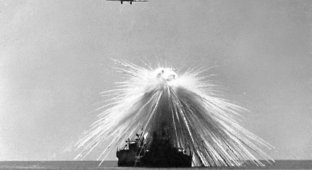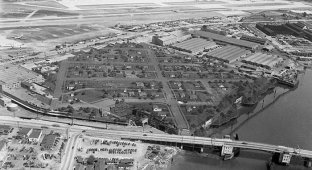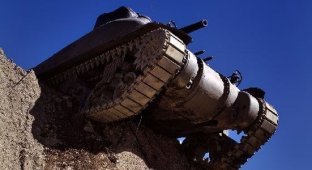As World War II came to an end, thousands of battered fighters, bombers, transports and other aircraft, many less than a year old before being scrapped and melted down, were stored in vast aircraft graveyards.
Shattered countries, torn by years of war, were eager to rebuild their economies, and war-weary populations were not averse to warplanes meeting their end in the hands of scrap merchants rather than the enemy. However, after some time, there was a great demand for the aircraft that went down in history of the war. They began to fetch a lot of money for entire aircraft; some examples were sold for millions of dollars. This article recounts the stories of classic fighters and bombers that crash-landed during World War II. Many of them were discovered decades later. And today, although some of them have been restored, most remain in isolated corners of the world.

"B-24D "Liberator" ("Liberator")", Atka Island

Shrouded in fog and haunted mainly by herds of deer, this crashed B-24D Liberator lies on Atka Island in Alaska's Aleutian Islands, where it intentionally crash-landed on December 9, 1942. This aircraft is one of eight surviving "D" Liberators (including "Lady Be Good", see below). He was on a weather reconnaissance mission when inclement weather prevented him from landing at any of the nearby airfields.
After trying different options, the pilot successfully landed on the fuselage and the crew left the plane. The only casualty was Brigadier General William E. Lind, who suffered a broken collarbone. Today, the terrain and the almost constant fog that surrounds the 100-kilometer island create an eerie atmosphere around the accident site. On the other hand, it all reflects the skill of the pilot, who was able to successfully land the Liberator (serial number 40-2367) on a piece of flat ground in bad weather.

Currently wrecked on Atka Island, the Liberator is part of the display at the World War II Pacific Memorial of Valor, which was established by US President George W. Bush on December 5, 2008.
"Messerschmitt BF-109", Russia

This is the Messerschmitt BF-109, which was built in 1939 and took part in the Battle of France and the Battle of Britain before being sent to the Eastern Front. This is probably one of the most intact planes that crashed. He was pulled out from under the water. During the flight of the German fighter ace Wolf Dietrich Wilcke, the plane was shot down by the Soviet Lend-Lease Hurricane system and was forced to land on a frozen lake.

Wilke escaped death, the plane remained almost unharmed after an almost perfect emergency landing until it plunged to the bottom of the lake. There it remained untouched for more than six decades, until it was finally raised in 2003. Countless bullet holes located on the plane's wings and horizontal stabilizers were one of the main reasons for the plane's accident, but one large hole in the right wing attachment point may have been what killed the fighter. If you do not pay attention to this, then the Messerschmitt BF-109 could be called an aircraft preserved in perfect condition.

In fact, the plane was in such good condition that the undercarriage was still able to support the weight of the plane after it was recovered from the bottom by members of the rescue team. The pilot, call sign "109", Wilke, was killed the following year. But it is reminiscent of a crashed fighter plane, on which the first layer of desert camouflage is still visible from under its yellow paint in the nose of the fuselage.
"Focke-Wulf Fw-190" "Yellow-16", Norway

Designed by German aeronautical engineer Kurt Tank, the Focke-Wulf Fw-190 "Strangler" was one of the most successful fighter aircraft of World War II. Entering service in August 1941, it was popular among pilots and was flown by some of the Luftwaffe's most elite fighter aces. During the war years, more than 20,000 of these aircraft were produced. Only 23 aircraft survive in complete configuration, and they are all in different collections around the world. So it was an exciting moment when this remarkably preserved Fw-190 was recovered from the cold waters off the Norwegian island of Sotra, west of Bergen. (Bottom: similar to the surviving "W?rger").

The fighter, raised from a depth of about 60 meters on November 1, 2006, is missing a cover on the cockpit and part of the skin, and after being under water for a long time, the paint from the hull has practically peeled off. But the aircraft, which bore the code "Yellow-16" during its service life, is otherwise perfectly preserved, with Luftwaffe markings still visible on its wings and tail fin.

Yellow 16 was forced to make an emergency landing in the waters off Sotra Island in December 1943. The pilot, whose identity is unknown, survived the dive and rose to the surface. But his plane soon sank into a watery grave, where he was destined to remain for the next 63 years.
Emergency Junkers Ju-88, Spitsbergen

Early versions of the German Luftwaffe's Junkers Ju-88 aircraft, which entered service in 1939, underwent many technical modifications during their development. But once these were eliminated, the twin-engine Ju-88 became one of the most versatile combat aircraft of World War II, serving in a variety of roles from torpedo bomber to heavy reconnaissance fighter.

But this particular plane did not serve long, making an emergency landing in 1942 on Spitsbergen, a remote archipelago in the Arctic Ocean halfway between mainland Norway and the North Pole. Its isolated location, however, protected the destroyed aircraft from scrapping, souvenir hunters and vandals, and made it a welcome addition to the few surviving Ju-88s.
“Liberator B-24” - “Lady Be Good”, Libya

When the American heavy bomber known to the United States Army Air Forces as the "Lady Be Good - B-24 Liberator" went missing on April 4, 1943, during a raid on Naples, it was assumed that the ill-fated aircraft was yet another of the countless military aircraft that fell into the sea. . This was believed until 1958, when the surviving Liberator was discovered by a BP oil exploration team deep in the inhospitable Libyan Desert, 700 kilometers from the coast.

Evidence recovered from the crash site suggested that the crew bailed out of the B-24D. The plane then continued to fly with one engine running, slowly descending until it finally landed on the desert sand at a slight angle. The crew were then reunited, but all died of thirst on the eighth day in the desert in a tragic attempt to find help. Five bodies of the pilots of this plane were found 130 kilometers from the crash site.

Broken into two large pieces but otherwise well preserved, Lady Be Good was still in fairly good condition, containing machine guns and a radio, and a thermos of tea was found. If the crew had headed south instead of north, they might have survived.

The bodies of eight of the nine crew members were found and sent to the United States. The ninth man on the airship is still listed as missing, although it is now believed that his unidentified remains may have been buried by a British patrol in 1953 who knew nothing of the Allied plane crashing in the desert. One of the many aircraft that never made it back to its base in North Africa, Lady Be Good has been restored and preserved to protect it from souvenir hunters.
"Brewster F2A Buffalo" - "BW-372", Russia

When this downed Brewster F2A Buffalo was pulled from the waters of a cold Arctic lake near Murmansk, Russia received the only surviving example of this model in the world. A strange plane, serial number BW-372, was forced to make an emergency landing on a frozen lake.

Its pilot, Finnish fighter ace Lauri Pekuri, was shot down in an air battle over the Soviet Segezha airfield in the Murmansk region. Pekuri had already shot down two Russian planes before he was forced to land his own. The pilot left the damaged Brewster and reached his position.

The plane, which broke through the ice and quickly sank to the bottom of the large Kolajärve lake, was recovered in 1998, after four years of searching. The remarkably preserved wreck of BW-372 was originally displayed at the Finnish Central Aviation Museum before moving to the Naval Aviation Museum in Pensacola, Florida, USA.
"B-17 Flying Fortress" - "Swamp Ghost", Papua New Guinea

In 1972, when the RAAF (Royal Australian Air Force) discovered an intact B-17 Flying Fortress No. 41-2446 in the Agaimbo Swamp in Oro Province during a helicopter exercise, maintenance personnel assumed that they stumbled upon one of the best preserved wrecks of a World War II aircraft. The place where the discovery was made was aptly dubbed the “Swamp Ghost.” Thanks to the efforts of rescuers, the find eventually made its way to the United States.

The half-sunken Flying Fortress No. 41-2446 had lain in Aghaimbo Swamp since 1942, where its captain, Frederick Fred Eaton, Jr., made an emergency landing after his aircraft was damaged by enemy fighters over Rabaul in East New Britain. Despite several bullets, shattered plexiglass and bent propellers, the B-17E showed little corrosion and was finally salvaged 70 years after crashing into the ground. The Swamp Ghost is currently being restored at the Pacific Aviation Museum in Pearl Harbor, Hawaii.
Douglas SBD "Dauntless" Lake Michigan

You don't always have to travel deep into isolated areas of former European and Pacific theaters to find the wreckage of a long-lost aircraft from World War II. This Douglas SBD "Dauntless", a Battle of Midway veteran, was salvaged from the waters of Lake Michigan in 1994. Carrying the build number 2106, the vintage fighter-bomber left the El Segundo, California, factory in December 1940 for shipment to the Far East, where it was primarily to be used against the mighty ships of the Imperial Japanese Navy.

In June 1942, during a raid on Japanese aircraft carriers west of Midway, the Neustrashimy was riddled with 219 bullets and was one of only eight aircraft to return to base out of 16 that had departed. The aircraft returned to the United States for repairs and was eventually sent to the Qualified Airlift Facility in Glenue, Illinois. It was there, one morning in June 1943, that a student pilot was forced to scuttle Neustrashimy No. 2106 after deviating from her route during a training flight to the USS Sable. The crashed aircraft remained in the dark depths of Lake Michigan until 1994, when it was recovered and sent to the US National Museum of Naval Aviation in Pensacola, Florida, for restoration.
"Bell P-39 Airacobra" ("Airacobra"), Russia

This is one of nearly 10,000 P-39 Airacobra fighters built by Bell Aircraft during World War II. This aircraft was delivered to Russia in accordance with the Lend-Lease supply agreement. But when 22-year-old pilot Lieutenant Ivan Baranovsky, a combat veteran with seven downed planes to his name, was forced to land his plane on a frozen lake above the Arctic Circle on November 19, 1944, his short military career ended.

60 years passed, and in 2004, a Russian fisherman looked into the shallow waters of a lake near Murmansk, where he saw the outline of a Bell P-39 - embedded in the silt after the crash, it was nevertheless clearly visible. Airacobra, serial number 44-2911, later returned to the United States for restoration at the Niagara Aerospace Museum in Buffalo, New York, in the same hangar where it was built many years ago.
Abandoned Mitsubishi Zero Hulk, Mariana Islands

Half-buried at an abandoned military airfield in the shadow of the mighty Mount Pagan volcano, the skeletal remains of this Mitsubishi A6M5 Zero fighter jet are the remains of one of two Japanese aircraft that crashed on the western side of Pagan Island, part of the Mariana Islands. Today, the American flag flies over the former thousand-meter dirt runway, built in 1935 by the 2,150-man Imperial Japanese Navy garrison. Bagan Island is now a picturesque place, but it still bears the scars of war.
"Boeing B-17 Flying Fortress "Gray Ghost"", Papua New Guinea

Situated on a hillside near Black Cat Pass in Papua New Guinea, where pilot Raymond S. Dow of Arlington, Virginia, masterfully crash-landed in 1943, the Boeing B-17 Flying Fortress has become famous - in recent years - under the name "Grey Ghost". The aircraft, made at the Boeing plant, took off from Port Moresby in the Philippines to attack a Japanese convoy leaving the port of Lae. But when the B-17 was severely damaged by anti-aircraft fire, Dow was left with no choice but to attempt an emergency landing on a deserted hillside. The crew survived, only radio operator Robert Albright died from wounds received during the raid. The Gray Ghost was originally intended for the Royal Australian Air Force under the Lend-Lease agreement, but was redirected to the Pacific theater due to the escalation of the conflict in the Far East. The British markings were removed from the aircraft and replaced with American markings, but over time they reappeared.
Curtiss P-40 Kittyhawk, Sahara Desert

In May 2012, oil workers came across a Kittyhawk P-40 fighter jet, slightly damaged after a crash, the disappearance of which, along with its pilot, 24-year-old Lt. Dennis Copping, remained a mystery for 70 years. On June 28, 1942, he was tasked with transporting a damaged No. 260 Squadron aircraft from one air force base in Egypt to another for repairs. Copping and his plane disappeared.

When a Polish team stumbled upon a crashed plane exposed to the sun-baked Sahara Desert, they discovered an eerily frozen scene in time, what historians would soon call "the aviation equivalent of Tutankhamun's tomb." But despite the amazing condition of the American-built Kitty Hawk, the remains of Lieutenant Copping could not be found anywhere.

A month later, an Italian team, a few kilometers from the crash site, came across human remains along with a piece of a torn parachute, a key fob with the number 61, and metal buttons dating back to 1939. But Copping's relatives' hopes were dashed when it proved impossible to extract DNA from the bones.

Although the Royal Australian Air Force Museum at Hendon has indicated its interest in the aircraft, the UK government has been criticized for its handling of the case. The P-40 is in the possession of the Egyptian authorities in a storage box in El Alamein. Meanwhile, it was reported earlier this year that, apparently without thinking, the Australian Air Force Museum may have promised the rescue team one of its rare Spitfires as payment for a Kittyhawk it couldn't purchase anywhere.
























